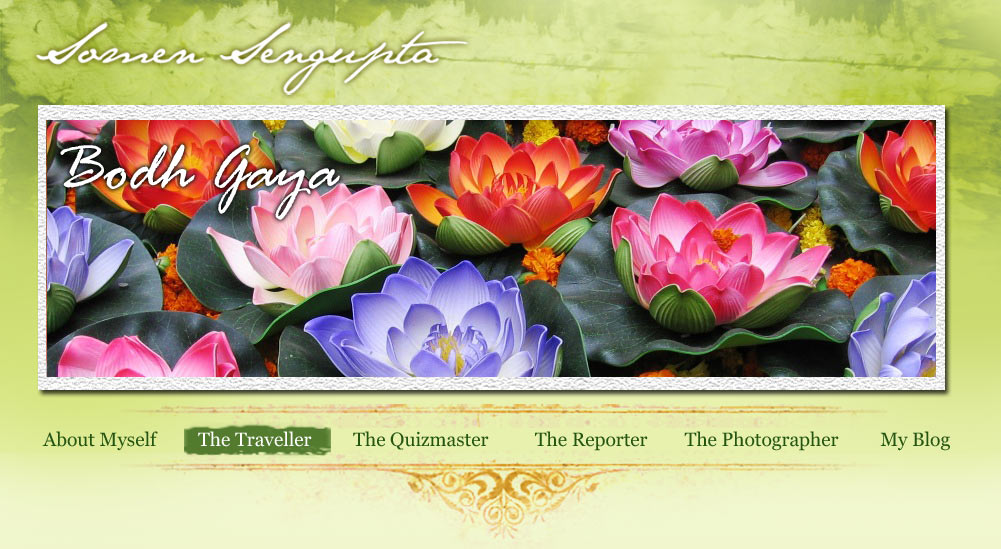| BODH GAYA - THE SEAT OF ENLIGHTENMENT |
|
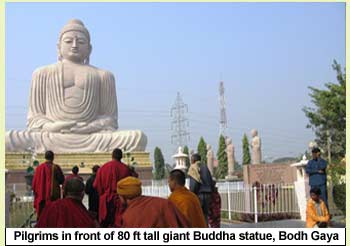 Nearly 2500 years ago mankind experienced its first revolution when a young prince from Himalayan kingdom left every luxury, comfort and lust of life behind him to search the path of nirvana. He braved every single difficulty that is possible on this earth to reach miles away from his home Kapilavastu and finally after six years arrived at a small village named Uruvela on the bank of river Lilanjana or Niranjana. Here to attain ultimate enlightenment he went on self suffering by starvation and soon turned emaciated. When he was about to die a girl from village named Bakrur saved his life by offering a diet of milk, rice and honey. This made the man realise that self suffering can’t take him to enlightenment; rather knowing the cause of suffering can take him there. The man choose a pipal tree and under that went on a penance. After 49th day in the full moon of Vaishakha in 528 BC he attained supreme enlightenment. Prince Goutama Sidhartha became Buddha, the first man on this planet who talked about the equality of mankind and the path that leads to ultimate nirvana. Nearly 2500 years ago mankind experienced its first revolution when a young prince from Himalayan kingdom left every luxury, comfort and lust of life behind him to search the path of nirvana. He braved every single difficulty that is possible on this earth to reach miles away from his home Kapilavastu and finally after six years arrived at a small village named Uruvela on the bank of river Lilanjana or Niranjana. Here to attain ultimate enlightenment he went on self suffering by starvation and soon turned emaciated. When he was about to die a girl from village named Bakrur saved his life by offering a diet of milk, rice and honey. This made the man realise that self suffering can’t take him to enlightenment; rather knowing the cause of suffering can take him there. The man choose a pipal tree and under that went on a penance. After 49th day in the full moon of Vaishakha in 528 BC he attained supreme enlightenment. Prince Goutama Sidhartha became Buddha, the first man on this planet who talked about the equality of mankind and the path that leads to ultimate nirvana.
Thus starts the story of Uruvela or Sambodhi which is now known to the world as Bodh Gaya. Bodh Gaya is considered as the holiest place in Buddhism. For all Buddhists across the world a visit to Bodhgaya is a lifetime desire. Even Hindus who once tried to project Buddha as one of the incarnation of Vishnu consider this place sacred. In his religious importance and in its archeological grandeur Bodh Gaya is a place that attracts all. The thrill one can feel under the shadow of a 2500 years old tree or on entering a huge temple housing a 1500 years old statue is just unimaginable.
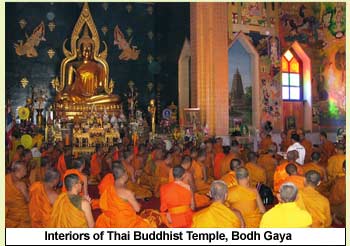 Today’s Bodh Gaya in an international pilgrimage city. Dotted with various modern and ancient monuments the place is abuzz with people across the globe. The centre of all is Mahabodhi temple complex where the legendary pipal tree still standsnext to a 1500 years old temple.The place Sambodhi was first highlighted by Ashoka who explored the place in 289 BC. He constructed a red sandstone throne around the tree named Vajrasana -the diamond seat of enlightenment. He also constructed the first temple here named Mahabodhi temple. Although that temple was destroyed long back, the stone railing that surrounds the complex is believed to be part of the temple established by Ashoka. Indeed there are two layers of stone found in this railing and they are from different era. The older one is made of sandstone made in 150 BC while the newer one is made of unpolished coarse granite. There many Hindu motifs found on these railing. Today’s Bodh Gaya in an international pilgrimage city. Dotted with various modern and ancient monuments the place is abuzz with people across the globe. The centre of all is Mahabodhi temple complex where the legendary pipal tree still standsnext to a 1500 years old temple.The place Sambodhi was first highlighted by Ashoka who explored the place in 289 BC. He constructed a red sandstone throne around the tree named Vajrasana -the diamond seat of enlightenment. He also constructed the first temple here named Mahabodhi temple. Although that temple was destroyed long back, the stone railing that surrounds the complex is believed to be part of the temple established by Ashoka. Indeed there are two layers of stone found in this railing and they are from different era. The older one is made of sandstone made in 150 BC while the newer one is made of unpolished coarse granite. There many Hindu motifs found on these railing.
It was through Ahoka Buddhism spread across India and in Central and Southwest Asia. A sapling ofthat pipal tree which is known as Mahabodhi tree was sent to Sri Lanka through his son Mahendra and daughter Sanghamitra. The original temple is long gone. A popular opinion says that the temple was constructed by one Upa Gupta who got 1 lakh gold coins from Ashoka to build it.
There is no doubt that the temple was constructed in 5th-6th century because in 635 AD when Chinese traveler Xuan Xang visited the place, the temple was already in it’spresent form as described by him.History is not very clear who exactly constructed the present temple which was laterrestored when Sir Alexander Cunningham was the chief of Archeological Survey of India. He was helped by J D Beglar and an Indian named Raja Rajendralal Mitra. Their hardwork conducted between 1877to 1880 unearthed a huge number of votive stupas and monasteries which are still visible all around the temple complex.
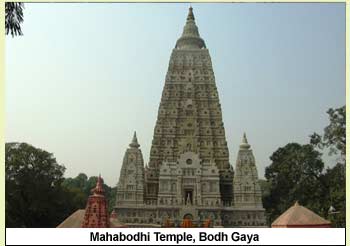 Plethora of artefacts and coins were unearthed from the site. In 1885 Sir Edwin Arnold visited the place and he first popularized it in the world by initiating series of articles and sketches. The temple was then under the control of Hindus. In 1891, Aganarika Dharmapala, a Buddhist monk from Sri Lanka fought to get it from the Hindus but failed. It finally came under the control of Government in 1949.The Mahabodhi temple complex was attacked many a time. Shashanka the Hindu king of Bengal, a firm believer of Shiva attacked the place and cut the Bodhi tree from its root. To ensure its total abolishment he ordered sugarcane juice to be poured on its ground. The tree died, but soon a sapling from Sri Lanka where years ago Ashoka’s children had planted the sapling from the original tree was called for. Plethora of artefacts and coins were unearthed from the site. In 1885 Sir Edwin Arnold visited the place and he first popularized it in the world by initiating series of articles and sketches. The temple was then under the control of Hindus. In 1891, Aganarika Dharmapala, a Buddhist monk from Sri Lanka fought to get it from the Hindus but failed. It finally came under the control of Government in 1949.The Mahabodhi temple complex was attacked many a time. Shashanka the Hindu king of Bengal, a firm believer of Shiva attacked the place and cut the Bodhi tree from its root. To ensure its total abolishment he ordered sugarcane juice to be poured on its ground. The tree died, but soon a sapling from Sri Lanka where years ago Ashoka’s children had planted the sapling from the original tree was called for.
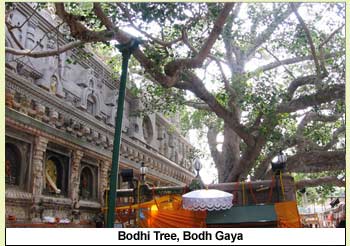 The sapling was replanted at the original place and it bloomed. The tree that one can see today is the 5th generation. The fall of Buddhism after the decline of Pala dynasty of Bengal and emergence of Sena who are not pro-Buddhist gave a bolt to Mahabodhi temple. The place soon became abandoned and thereafter was vandalized by Islamic invaders from 12th century onwards. 1105 Burmese monks did a huge restoration. The 180 ft high and 60 ft wide double storied pyramidal shaped brick temple is a feast for your eyes. It is in fact one of the oldest surviving brick monuments in India. The central tower is surrounded with several small towers and each of them is curved with various floral designs. The huge Buddha statue seated in Bhumisparsha posture housed inside the sanctum is made of black stone and painted gold. It was gifted by Pala kings of Bengal. Thailand Government has gifted 290 kg of gold plate to this temple. The sapling was replanted at the original place and it bloomed. The tree that one can see today is the 5th generation. The fall of Buddhism after the decline of Pala dynasty of Bengal and emergence of Sena who are not pro-Buddhist gave a bolt to Mahabodhi temple. The place soon became abandoned and thereafter was vandalized by Islamic invaders from 12th century onwards. 1105 Burmese monks did a huge restoration. The 180 ft high and 60 ft wide double storied pyramidal shaped brick temple is a feast for your eyes. It is in fact one of the oldest surviving brick monuments in India. The central tower is surrounded with several small towers and each of them is curved with various floral designs. The huge Buddha statue seated in Bhumisparsha posture housed inside the sanctum is made of black stone and painted gold. It was gifted by Pala kings of Bengal. Thailand Government has gifted 290 kg of gold plate to this temple.
Now a UNESCO world heritage site temple wall upholds excellent stone curving of Jataka and various Buddha figures. An army of pilgrims mostly from oriental countries take their places between the western wall of the temple and the holy tree. They offer colourful paper lotus and oil lamps to Buddha. The deep meditation in solitude binds the world under the footprint of Buddha. The complex has many more things to see.
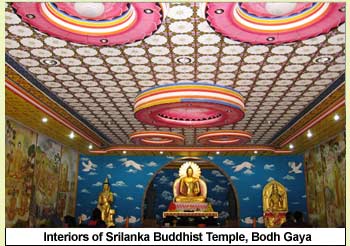 As per Buddhist mythology Buddha spent seven weeks in this place and each week is still marked inside the temple complex. During the entire second week, Buddha stood with motionless eyes without batting lid. The place is now marked with a small temple called animeshlochana chaitya. Muchilanda lake is to be believed where he spent 6th week while Ajapala Nigrodha tree saw him in penance in 5th week of his stay. From here Buddha spoke about the equality of mankind. The tree is long gone but now a stone pillar marks the place. A place called Rajyanta tree inside the complex is believed to be the place where he spent his last week. Here two Burmese merchants Tapassu and Bhallika offered food to Buddha and took refuge in him. The stone that curves his foot print and Buddha in Bhumisparsha mudra are more special things to note. As per Buddhist mythology Buddha spent seven weeks in this place and each week is still marked inside the temple complex. During the entire second week, Buddha stood with motionless eyes without batting lid. The place is now marked with a small temple called animeshlochana chaitya. Muchilanda lake is to be believed where he spent 6th week while Ajapala Nigrodha tree saw him in penance in 5th week of his stay. From here Buddha spoke about the equality of mankind. The tree is long gone but now a stone pillar marks the place. A place called Rajyanta tree inside the complex is believed to be the place where he spent his last week. Here two Burmese merchants Tapassu and Bhallika offered food to Buddha and took refuge in him. The stone that curves his foot print and Buddha in Bhumisparsha mudra are more special things to note.
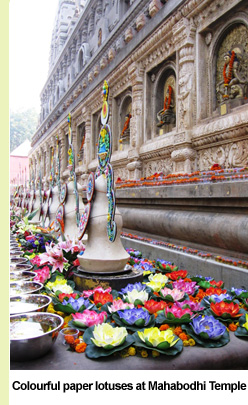 Outside the complex the town is a gallery of international Buddhist temples. Name any country where Buddhism is popular and it has established a magnificent temple here. The first one came in 1938 by Tibet then an independent country. China temple which houses three unique Buddha statues was set up in 1945. The biggest and the most expensive temple structure was made by Thailand in 1957. The temple is just a replica of any big Buddhist temple of Bangkok with its golden tiled roof and huge human figures. Outside the complex the town is a gallery of international Buddhist temples. Name any country where Buddhism is popular and it has established a magnificent temple here. The first one came in 1938 by Tibet then an independent country. China temple which houses three unique Buddha statues was set up in 1945. The biggest and the most expensive temple structure was made by Thailand in 1957. The temple is just a replica of any big Buddhist temple of Bangkok with its golden tiled roof and huge human figures.
Countries like Vietnam, Sri Lanka, Japan, Burma, Bangladesh, Korea, Nepal all have their own Buddha temple and each one is distinctive in its architecture. The biggest attraction of Bodh Gaya’s modern monument is an 80 ft tall giantBuddha statue. A gift from Japan to India in 1989, the statue made of off-white sand stone is a masterpiece. Set next to Japanese temple the seated Buddha with his half open eye lid makes a huge impact on the atmosphere. This statue was inaugurated by Dalai Lama. 5 km from the town stands Sujata griha a brick stupa built in the memory of Sujata who saved the life of Buddha.
In nutshell Bodh Gaya contains a rich past and even richer presence. It is the place where India’s glorious history and noble teaching lord over the world under the shadow of a man who 2500 years ago changed our way of lives for ever.
Travel Logistics :
Bodh Gaya is 95 km from Patna which is very well connected from all parts of the country. Bihar tourism has regular AC bus services from Patna city - It takes nearly three hours to reach the place. Gaya has an international airport connected from Thailand, Sri Lanka & Bhutan. Gaya is the nearest rail heads - from there by car it is a 40 minutes journey. Mahabodhi temple complex is illuminated at night. An excellent museum by ASI near the temple is a must visit. Many artefacts excavated from the place are on display. It is closed on Monday. Plethora of hotels with good options of eating joints. Accomodation is provided by Bihar Tourism also. You can club Nalanda & Rajgir with this tour.
Helpful website:
www.bihartourism.gov.in
This article was published on 30th November 2014 in The Hitavada
Click here to view the original article |
